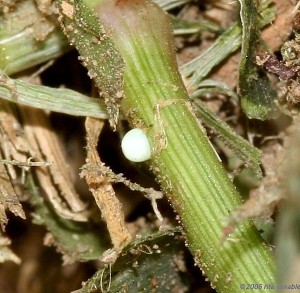I was meandering about in the yard when I spied a female Sachem laying an egg on white clover (Trifolium repens L.). Sachems are skippers, but for some reason we leave off the “skipper” part of the common name; it’s just “Sachem.”
Female Sachems have a backwards chevron on their hindwings when see from below. They are fertile lasses. We have observed hundreds on the NABA Fourth of July Butterfly Counts in Nashville.
I found the egg by turning the clover leaf over. After picking the clover leaf, I put it and the egg beside some crabgrass ((Digitaria spp.) that I had potted up earlier not in view of my neighbors, who are, as I write, trying desperately to get rid of it in their lawns. Why crabgrass? It is one of the hostplants of the Sachem. [Note: So is Bermuda grass! No wonder we have so many Sachems…] I don’t know why this female laid her egg on clover; it is not listed as a hostplant. Crabgrass was listed, so I figured as long as the egg hadn’t hatched yet, it was better to take a chance on the crabgrass. Maybe she was a young Sachem and didn’t really have the hostplant thing down yet. The egg looks like a hemisphere, and here is a photo of one on some crabgrass. This was taken a week or two before I found the one on the clover, which I did not take a photo of.
The egg hatched seven days later, and for many days I lost sight of the caterpillar because of its small size and “hide-ability.” Here’s what an early instar looks like.
The caterpillar is well-hidden at the base of the crabgrass, where it can handily escape the lawn mower blade. I had to hunt for this hiding place with a toothpick lifting the soil around the base of the plant very gently.
Now the caterpillar is growing larger, and I think it’s preparing to pupate. There is lots of frass in the dirt and little grass snippets in the container, however, I have never seen the caterpillar actually eating. You can see its relative size by comparing it to my finger and the yellow toothpick (left) in the photo.
This photo was taken on September 17. The caterpillar is now 18 days old. Still, I have never seen the caterpillar without looking around at the base of the plant; it is yet to be in plain view.
As I observe this little caterpillar several questions arise about it, such as:
How does this species survive the fall spraying for crabgrass and Bermuda grass that many homeowners use?
Do golf courses with Bermuda grass encourage the species?
What are the caterpillar predators?
Why is it so successful as a species?
I await answers and pupation. It will be interesting to see what the chrysalis looks like.
©Rita Venable 2006





